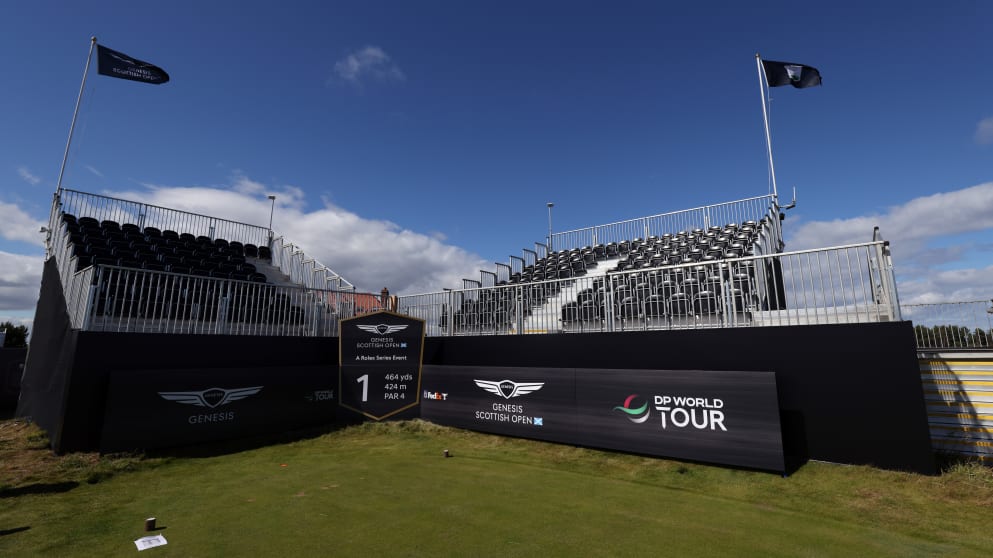The Genesis Scottish Open returns to The Renaissance Club for the fourth consecutive year, with a high-calibre global field assembled at the third Rolex Series event of the 2022 DP World Tour season.

The tournament is co-sanctioned by the DP World Tour and PGA TOUR for the first time this year, with all four current Major Championship winners making the visit to the East Lothian venue.
Three-time Major Champion Pádraig Harrington has consulted with course designer, Tom Doak, and The Renaissance Club CEO Jerry Sarvadi over the past two years in reconfigurations to the layout and gives us the inside track on a players’ perspective of the challenge that awaits the world’s best golfers this week.

Hole 1:
A new bunker has been added in the right half of the fairway, so the tee shot now requires most players to lay-up with a long iron to leave a six or seven iron into the green. However, long hitters could attempt to carry the bunker at 305 yards. The difficulty of this hole is around the green – the back pin positions are generous and offer good birdie chances but the front positions are very difficult. You certainly don’t want to short-side yourself as it is a very narrow target and difficult to get the ball to stop on the very front plateau and not run away 30 or 40 feet.
Hole 2:
A big long par four! Off the tee you want to avoid the bunkers on the left. The bail-out used to be on the right, but some mounding has been added in the rough, providing difficulty and putting a premium on the tee shot. The second shot can be a four iron into an elevated green, so it suits a good ball striker, as it can be a struggle to get it on the right tier and in position in two shots. It is not too difficult around the green and does offer opportunities of getting up and down, despite it being raised. Most players would be happy making par on this hole.
Hole 3:
The first par five is a very generous hole if you play it as a three shotter – hit your tee shot down the left, lay-up with your second and hit a little wedge into the green. If you want to take it on, you have to keep the tee shot tight to the right-hand trees, given that it is a dogleg to the right. A good drive will leave you a long second shot, but it does release onto the green so you can reach from 260 to 280 yards. A couple of cross bunkers at about 60 yards short are to be avoided. It is an inviting second shot but if you can avoid the bunker down the left, it sets up a nice opportunity for a birdie. It’s a difficult green but it can lead to second shots feeding towards the hole resulting in some eagles.
Hole 4:
A new bunker has been put in on the left side of the fairway at 277 yards to tighten the tee shot. It will entice players to hit driver more often and be a bit more aggressive off the tee - previously players hit fairway woods and were happy enough in the left rough, but now need to take on the hole from the tee. The second shot is to an elevated green, but once you are in play off the tee, it provides a good opportunity to hit it close. However, there are a few slopes on the green so distance control is key.
Hole 5:
A nice short par four. This hole is regularly driven from the tee as a good accurate drive between two walls at about 280 yards can release and run onto the green. If playing into the wind, players will lay-up, but if players drive beyond the wall, they will need to avoid a pot bunker and hopefully get it on the right tier. Definitely a good opportunity for a birdie.
Hole 6:
A devilish little par three. Front and middle pins are the most difficult even though players could be hitting a sand wedge, but accuracy and spin control need to be right because the green falls off to the left and the right. You certainly don’t want to miss it right, which leaves a difficult up and down, although from the left it is not too bad. Whilst it is a longer hole when they use the back pins, the green feeds from back left into the middle of the green, which many players will play for when the pin is on the right. However, it is key not to go long because it falls away at the back. For a short par three this hole generates lot of frustration as you can easily make a bogey.
Hole 7:
This hole is a par four this year, whilst members play it as a par five. There are bunkers at 295 yards to carry off the tee and a pot bunker at 334, which big hitters have to decide whether to go right or left of. It is a challenging second shot for a par four and it can be a drive and a four iron. It has a large green with slopes that can feed the ball to the hole so you will see a few birdies. It is a tough par four, but you are disappointed if you didn’t make your par.
Hole 8:
One of the tougher holes on the course. With a carry of about 310 yards over the bunkers, most players will lay up short of them, some with a fairway wood if it is playing fast. From there you generally hit a seven or eight iron to an elevated green that has a false front. It is a difficult green to get the ball on the right plateau and close to the pin, although most players will make a comfortable par.
Hole 9:
A medium length par three. It tends to play into the wind so three or four iron is generally required. Two large bunkers down the right need to be avoided. There is plenty of room left so even though it’s a small green and target, you can be ten yards left of the green and have a reasonable chip or putt. It has an interesting green but if you do hit a good shot you have a good chance for birdie.

Hole 10:
Reconfigured from the tee. Some sand dunes with marram grass have been incorporated down the right and down the left two new fairway bunkers have been added. Interestingly it should make the hole a little easier given the improvement in aesthetics as it will give a better sight line off the tee and the mounds could kick the balls into the fairway. The difficulty is always the second shot. With a large mound in front of the green, the player needs to decide whether to land short of it, on it or over it. However, the key is where you the miss is - if pins are on the right of the green, missing the green on the left is fine as it is a relatively easy chip and putt. If on the left you can’t miss on the left as you will be short sided, so you need to keep it down the right. You feel that you should make birdie but you are frustrated when you don’t.
Hole 11:
Difficult par four that can play very long into the wind. The drive is played uphill and you don’t want to miss to the right, given the huge tree and mounding, where there is little chance to reach the green and could be the worse miss on the golf course. However, a drive up the left makes the hole play longer, especially into the wind. The second shot is too a narrow green where you can’t miss left. There is a bit of room right, where shots gather and you can chip and putt from the edge of the green. The slope at the back of the green has been softened to bring in new pin positions. Overall, good shots in can result in birdies as balls tend to gather to the pin and it is a good risk reward hole.
Hole 12:
Interesting par three. Not too long at 200 yards to a large green. However, players have found it difficult over the years as the green is set up against the horizon, which makes it tough to find a target to aim at and provides full exposure to the wind. In addition, distance control and getting the clubbing correct is challenging, so it is hard to hit it close. Players are happy to make three at this hole and move on.
Hole 13:
The signature hole of the course. It is a short dog leg around the water, which plays very straight-forward in practise, but difficult when the wind is off the left hand side. The carry off the tee is over the Out of Bounds, so players bail out right. It should be an easy hole if you are playing well - big target, fairway cambers from the right, and it could only be a wedge or nine iron into the green. However, there is a fall off to the left of green, so you need to decide whether to feed it in from the right or go straight for the flag. If the former, it can easily come up short, but if you go for it and miss left, it is a tough up and down when the pin is also on the left. Another great risk reward hole.
Hole 14:
Nice short par three. The tee shot normally requires between a nine iron, or up to a seven iron if it is into the wind. The green is in a hollow, which kicks in from the left and has a back stop on the right, before a wall you don’t want to hit up against. There have been many birdies over the years - there are plenty of slopes and undulations on the green, but you will see many shots hit close here. Definitely a great birdie opportunity.
Hole 15:
Long par four, although we have tended not to use the back tee. It is slightly blind off the back tee, so hard to know exactly where the right-hand fairway bunkers are. It is a big target, although you see players play up the left side which lengthens the hole significantly. It is played to a large green, with a bunker at the front, so the easier pins are at the back of the green. If the pin is at the front it is tough to get it close, but players generally aim past the pin and make an easy par. Whilst a long hole, it is one I would always take on and hope to make birdie if I hit a good shot in.
Hole 16:
Nice risk reward par five. There are bunkers down the left which need to be avoided - hit it in there and you are bringing bogey into play. Therefore, players bail out into the rough on the right, which could mean the green isn’t reachable if it is into the wind, but if downwind you can still get to the green. The second shot is somewhat blind for most of the field, but it is downhill so you can pitch it short and run it on. It is an exceptionally undulating green, which falls away to the back left. Whist hitting the green in two is easier said than done, we have seen plenty of eagles over the years. There are plenty of options of getting up and down, but you don’t want to be short left if the pin is left or short right if the pin is on the right.
Hole 17:
Good par three at this stage of the round. Generally, it is about 210 yards and a five iron at times into the wind. There is a false front to the green with a bunker on the left, so you don’t want to be short. There is a tier on the front left of the green, where balls feed down to, so if the pin is there then there is a good chance of birdie. A front right pin has a slope short of it, so players tend to putt back to that pin. Pins at the back of the green seem to result in lots of birdies as the ball tends to come back off slopes. An errant tee shot, can mean a close to impossible two putt given the slopes on the greens, so the hole definitely rewards a good ball-striker.
Hole 18:
Strong par four especially if into the wind. Bunkers down the left have to be avoided, as you would need an exceptionally good lie to reach the green. There is one bunker down the right, which can be carried if conditions are favourable, leaving a seven or eight iron into the elevated green. If it is into the wind, it is a difficult tee shot between the bunkers, leaving a long iron to the green. Two bunkers on the right of the green are fine to play from if a decent lie, whilst there are run-offs on the left and over the back of the green, plus a bit of a false front which adds difficulty. The typical pin at the back of the green is difficult to get to, but it is worth taking it on. A miss left or long can be an awkward chip and putt, but you still have a good chance of getting up and down. There have not been a lot of birdies at this hole over the years. A solid par four 18th hole, where you are very content making a par.










